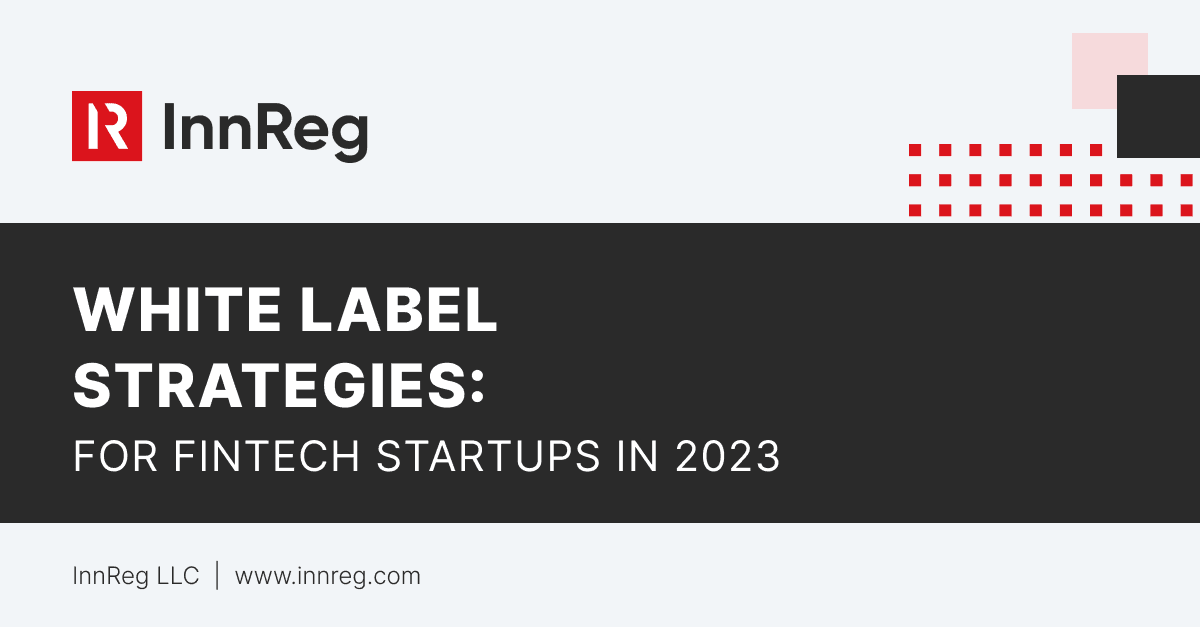Contents
When fintechs use white label strategies, they speed up market entry velocity and decrease the initial launch costs, among other benefits. In the long run, having own fintech software gives freedom and control over making and settling trades, accepting deposits, transmitting withdrawals to other accounts, verifying customer data during account opening, and more.
See also:

InnReg is a global regulatory compliance and operations consulting team serving financial services companies since 2013. If you need assistance with compliance or fintech regulations, click here.
“Build or Buy” - Your Biggest Decision
At the early stages of the product development process, fintech entrepreneurs must account for several factors that ultimately define their business and its opportunity to create value:
Optimal business model
Operating structure
Regulatory and compliance strategy
Required technology stack
As these decisions become more tangible, entrepreneurs inevitably face build versus buy decisions. Should you build custom user-facing functionality in-house?
Does it make more sense to leverage a white label program you can brand as your own?
Is it possible to integrate a mix of in-house and off-the-shelf solutions into a cohesive platform?
A Major, Common Misconception
Many early-stage entrepreneurs that we speak with at InnReg come to us assuming they have to do all of the heavy lifting themselves. The biggest goal they have is to become innovators in the field of emerging financial technologies. Entrepreneurs often feel that fintech, by definition, is designed to revolutionize the user experience and help them break loose from the pack. It seems counterintuitive to consider buying pieces of that innovation off-the-shelf.
The other side of the issue comes down to reinventing the wheel. Fintech innovations are abundant. In many situations, successful fintech business models delivered significant product differentiation and brand value using outsourced white label programs. We describe some of them below.
Advantages of the White Label Approach
Faster speed-to-market. The technology has already been tested in a live environment. You save substantial time while assuming less risk compared to custom development.
Reduced staffing costs. The technology has already been built and deployed. It also has support staff to handle fixes and upgrades. As a result, you need fewer in-house developers, and you save on recruitment, training, and management expenses.
Reduced infrastructure costs. Most white-label solutions are offered via a cloud-based Software-as-a-Service model. Hosting and maintaining them remains the responsibility of the provider. They won’t increase your operating costs or maintenance burden.
Disadvantages of the White Label Approach
Loss of control
You typically need to conform to the existing functionality, which could compromise some innovative aspects of your product design. You also inevitably compete for your provider’s resources with all the other platform users. Agreeing an appropriate service level is key. An expert such as InnReg can help you craft the contract, making sure you get a specific level of customization and a specific level of tech support from your provider.Upfront / pre-validation costs
Some providers start charging service fees when you sign the contract, so your budget could take a hit before the program has time to earn any sales revenue. Starting costs are another area where an outsourced expert can help you negotiate scaled pricing to minimize expenses while you’re still ramping up.Regulatory and compliance needs
Even if your fintech does not need to be licensed by any regulatory bodies, your white label provider might. White label providers may also have other compliance requirements that cascade down to the companies who use their technology. Many companies get caught short in this area. InnReg’s unique expertise in the compliance nuances of fintech and business model innovation can help you account for these issues before you ever sign an agreement with a white label provider. InnReg can also help you meet your provider’s required due diligence criteria.
Should Your Fintech Buy White Label Financial Products?
If you have decided to buy a component instead of build, it is time to determine how to get the most from the package. Start by doing your homework. Different white label providers offer different levels of customization at different price points. Brainstorm with your team on which features are critical to your core offering, and which features could be rolled out at a later stage. An outsourced white label expert like InnReg can facilitate this process by moderating the brainstorming session. We’ll also share our creative tricks of the trade for using an off-the-shelf package with a minimal negative impact on your innovative concept.
Typical Broker-Dealer Scenarios and Sample Solutions
High on Functionality, Low on Customization
If speed-to-market is more important than customization, then you should research a program like Interactive Brokers. This is one of several trading platforms that has created a white label program for independent investment advisors, brokers, and fund investment managers.
Their program allows trading professionals to offer their clients all the features of a state-of-the-art trading platform under their own name, logo, and brand identity. This strategy gets new brokers into the market fast. Moreover, they enjoy the instant credibility of offering their own branded technology. The platform is designed to be turnkey with only a minimal amount of technical integration.
The downside is the possibility of offering a parity platform that is identical to the competition. Adding unique services to the value proposition can address this problem and allow new brokers to differentiate in the marketplace.
Custom Features via Plug-and-Play APIs
If customization is king, then you should work with one of a growing number of technology companies that offer individual components via an API. Two strong providers in the plug-and-play field are Tradier and DriveWealth. Both companies allow financial advisors to build a custom roboadvisor platform by choosing the right assortment of components to support their value proposition.
Plug-and-play is a smart strategy being used by small and large companies. In fact, Lucid-Trend recently upgraded its features using a Tradier API. This integration allows them to provide their customers with advanced equity analysis and trade executions on the Lucid-Trend platform without the time and expense of custom programming.
When considering this option, be sure your provider offers the level of customization you need to differentiate your brand from the competition. Start by identifying the key features and functionality that support your value proposition. Then make sure your plug-and-play provider offers these features off their menu or can create them as a custom add-on at a reasonable price.
How InnReg Supports Build versus Buy Decisions
At InnReg, we’ve helped several fintech startups sort through the pros and cons of build versus buy for their own unique program.
In each case, our technology-neutral approach to the decision delivered the optimal stack to meet their needs after we considered their product, their business model, their resources, and their long-term growth strategy. We always make sure the launch platform can be scaled at peak performance levels to support growth without all new technology.
Are you wrestling with the pros and cons of build versus buy for your fintech startup? Contact us to discuss your questions and challenges.
How Can InnReg Help?
InnReg is a global regulatory compliance and operations consulting team serving financial services companies since 2013.
We are especially effective at launching and scaling fintechs with innovative compliance strategies and delivering cost-effective managed services, assisted by proprietary regtech solutions.
If you need help with compliance, reach out to our regulatory experts today:
Published on May 1, 2017
Last updated on Dec 2, 2023
Related Articles

All Fintech
Feb 12, 2025
·
11 min read

All Fintech
Dec 26, 2024
·
18 min read

All Fintech
Dec 11, 2024
·
8 min read
Latest LinkedIn Posts












